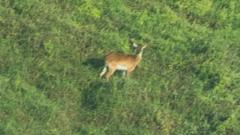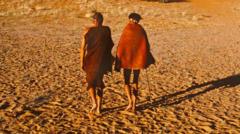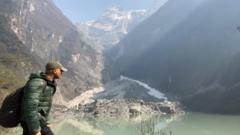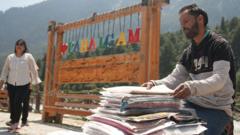As saltwater crocodiles rebound from near extinction, Australia’s Northern Territory confronts the challenge of managing their numbers amidst rising public concern about safety and the role of these apex predators in the ecosystem.
Crocodile Management Dilemma: Conservation vs. Culling in Australia's NT
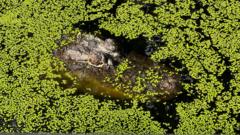
Crocodile Management Dilemma: Conservation vs. Culling in Australia's NT
How Australia navigates the challenges of thriving saltwater crocodile populations while keeping the public safe.
with wide eyes, Kelly Ewin, a government ranger in Australia’s Northern Territory, finds himself balancing on a floating trap in Darwin Harbour, tasked with the daunting job of capturing crocodiles. Despite storm clouds looming overhead, Ewin manages the tense silence, punctuated only by the splashing from within the trap. "You get pretty much zero chances with these guys," he remarks while trying to noose an agitated saltwater crocodile.
The Northern Territory (NT), known as Australia’s crocodile capital, is estimated to host around 100,000 wild saltwater crocodiles, more than any other location worldwide. The city of Darwin, surrounded by beaches and wetlands, has become a habitat where humans must coexist with these territorial and aggressive reptiles.
Saltwater crocodiles, colloquially known as "salties," nearly faced extinction fifty years ago, when uncontrolled hunting for their skins drove their numbers down to just about 3,000. However, after hunting was banned in 1971, their populations surged. They are now protected, thus raising concerns about their growing numbers and the need for responsible population management.
"The worst thing that can happen is when people turn against crocodiles," cautions croc expert Prof. Grahame Webb, noting that a political backlash could lead to impatient solutions for so-called crocodile problems.
In the NT’s hot climate, abundant waterways provide an ideal habitat for crocodiles, which hide and ambush their prey. Although fatal attacks are rare, last year marked a tragic event when a child was lost to a crocodile attack, reigniting debates about the proximity of these predators to humans.
As breeding season unfolds, Ewin and his team have their hands full, checking a network of crocodile traps strategically located around Darwin. Most crocodiles captured are removed permanently, aimed at minimizing human encounters. "It's our job to try and keep people as safe as we can," Ewin says, emphasizing the balance between conservation and public safety.
Education initiatives like the NT government’s "Be Crocwise" program are essential for teaching the community to coexist safely with crocodiles. Successful strategies from the program have drawn interest from places as far away as Florida and the Philippines, interested in how humans can live alongside such dangerous wildlife.
For now, mass culling is off the table due to the protected status of saltwater crocodiles, but a recent update to the government’s crocodile management plan has increased the quota for annual removals from 300 to 1,200. This, combined with ranger efforts, seeks to prevent potential encounters while maintaining ecological balance.
The economic impact of crocodiles is significant—not only do they attract tourists eager for "croc jumping" experiences, but they also fuel the fashion industry. Luxury brands depend on crocodile skins for high-value products, creating a complex relationship between conservation and commercialization. Farmers like Mick Burns partner with Indigenous communities to sustainably harvest crocodiles, giving new meaning to local engagement in wildlife management.
While many residents regard the iconic predator with fascination, the danger they pose remains palpable. Prof. Webb wisely warns against swimming in certain waters, attributing the risk to the high crocodile population. He speaks from experience, having survived an attack in his youth, where he barely escaped with his life.
As the Northern Territory grapples with the dilemma of living with and managing this prehistoric predator, the importance of a balanced approach is paramount to ensure both the safety of its residents and the preservation of the species that has become synonymous with the NT’s identity.
The Northern Territory (NT), known as Australia’s crocodile capital, is estimated to host around 100,000 wild saltwater crocodiles, more than any other location worldwide. The city of Darwin, surrounded by beaches and wetlands, has become a habitat where humans must coexist with these territorial and aggressive reptiles.
Saltwater crocodiles, colloquially known as "salties," nearly faced extinction fifty years ago, when uncontrolled hunting for their skins drove their numbers down to just about 3,000. However, after hunting was banned in 1971, their populations surged. They are now protected, thus raising concerns about their growing numbers and the need for responsible population management.
"The worst thing that can happen is when people turn against crocodiles," cautions croc expert Prof. Grahame Webb, noting that a political backlash could lead to impatient solutions for so-called crocodile problems.
In the NT’s hot climate, abundant waterways provide an ideal habitat for crocodiles, which hide and ambush their prey. Although fatal attacks are rare, last year marked a tragic event when a child was lost to a crocodile attack, reigniting debates about the proximity of these predators to humans.
As breeding season unfolds, Ewin and his team have their hands full, checking a network of crocodile traps strategically located around Darwin. Most crocodiles captured are removed permanently, aimed at minimizing human encounters. "It's our job to try and keep people as safe as we can," Ewin says, emphasizing the balance between conservation and public safety.
Education initiatives like the NT government’s "Be Crocwise" program are essential for teaching the community to coexist safely with crocodiles. Successful strategies from the program have drawn interest from places as far away as Florida and the Philippines, interested in how humans can live alongside such dangerous wildlife.
For now, mass culling is off the table due to the protected status of saltwater crocodiles, but a recent update to the government’s crocodile management plan has increased the quota for annual removals from 300 to 1,200. This, combined with ranger efforts, seeks to prevent potential encounters while maintaining ecological balance.
The economic impact of crocodiles is significant—not only do they attract tourists eager for "croc jumping" experiences, but they also fuel the fashion industry. Luxury brands depend on crocodile skins for high-value products, creating a complex relationship between conservation and commercialization. Farmers like Mick Burns partner with Indigenous communities to sustainably harvest crocodiles, giving new meaning to local engagement in wildlife management.
While many residents regard the iconic predator with fascination, the danger they pose remains palpable. Prof. Webb wisely warns against swimming in certain waters, attributing the risk to the high crocodile population. He speaks from experience, having survived an attack in his youth, where he barely escaped with his life.
As the Northern Territory grapples with the dilemma of living with and managing this prehistoric predator, the importance of a balanced approach is paramount to ensure both the safety of its residents and the preservation of the species that has become synonymous with the NT’s identity.





